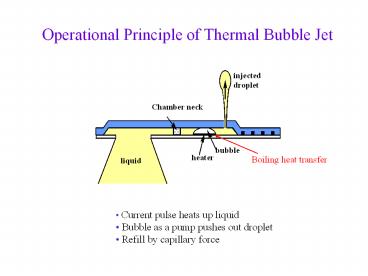Operational Principle of Thermal Bubble Jet - PowerPoint PPT Presentation
1 / 11
Title:
Operational Principle of Thermal Bubble Jet
Description:
Title: No Slide Title Author: C. Shih Last modified by: Dr. Chiang Shih Created Date: 11/25/1998 9:18:28 AM Document presentation format: On-screen Show – PowerPoint PPT presentation
Number of Views:74
Avg rating:3.0/5.0
Title: Operational Principle of Thermal Bubble Jet
1
Operational Principle of Thermal Bubble Jet
Boiling heat transfer
- Current pulse heats up liquid
- Bubble as a pump pushes out droplet
- Refill by capillary force
2
Satellite Droplets
Inkjet Droplet injection sequence
3
Micro-Machined Thermal Bubble Jet
Heater
Silicon Wafer
4
1-D Heat Conduction with Generation
Thin heater deposited on silicon can be modeled
as heat generation
T?,1, h1
T
L
Silicon Wafer thermal conductivity k
T?,2, h2
Ts
T
T?,2
T?,1
L/(kA)
1/(h2A)
1/(h1A)
q2
q1
5
1-D, steady Heat Transfer in Cylindrical
Coordinate
qrdrqr(dqr/dr)dr
qr-kAr(dT/dr)
Radial direction
6
Cylindrical Heat Conduction
7
Heat Loss from a Cylindrical Pipe (no insulation)
Steam at 300C flow in a cast iron circular pipe
(k80W/m.K). Determine the heat loss per unit
length of the pipe to the surroundings at
T?20C, with a combined (radiation convection)
heat transfer coefficient of h220 W/m2.K). The
convection coefficient inside the pipe is h150
W/m2.K)
r11 cm r21.25 cm
Rconv,2
T?
Rcond
Rconv,1
T
8
Heat Loss from a Cylindrical Pipe (no insulation)
(cont.)
Note the cast iron pipe is a good conductor,
therefore, it has a small thermal resistance. To
prevent heat loss, it is recommended that
insulation be used outside the pipe.
9
Insulation
It is suggested that a thick layer of insulation
(k0.5 W/m.K) be wrapped outside the pipe.
Determine the heat loss as a function of the
thickness of the fiber glass wrap.
Rconv,2
T?
Rinsulation
Rcond
Rconv,1
T
Assume the fiber thickness is t r3r2t
Rconv,1 and Rcond stay the same, unchanged
r1
r2
r3
r11 cm r21.25 cm
10
Insulation-2
- Plot this function in the following slide
11
Critical Radius of Insulation
Critical thickness
- Heat loss increases initially when one adds
insulation (why?) - Maximum heat loss at critical radius of
insulation that rcritical kinsul/houtside - In the present case, rcritical0.5/200.025
- Its critical thickness is t0.025-0.01250.0125(m
)
Note similar derivation can be made for a
spherical container. The critical radius for a
spherical shell is rcritical2k/h































